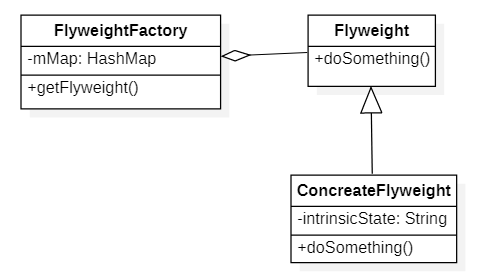享元模式—结构型
简介
享元模式(英文名称:Flyweight Design Pattern),所谓“享元”,顾名思义就是被共享的单元。享元模式的意图是复用对象,节省内存,前提是享元对象是不可变对象。定义中的“不可变对象”指的是,一旦通过构造函数初始化完成之后,它的状态(对象的成员变量或者属性)就不会再被修改了。所以,不可变对象不能暴露任何 set() 等修改内部状态的方法。
使用场景
1,项目中存在大量的相似对象;
2,需要缓冲池的场景
UML类图
FlyweightFactory:享元对象抽象基类或者接口;
ConcreateFlyweight:具体享元对象;
FlyweightFactory:享元工厂,祖泽管理享元对象池和创建享元对象;
示例
文本编辑器可以理解为word,为了简化,假设这个文本编辑器只实现了文字编辑功能,不包含图片、表格等复杂的编辑功能。对于简化之后的文本编辑器,我们要在内存中表示一个文本文件,只需要记录文字和格式两部分信息就可以了,其中,格式又包括文字的字体、大小、颜色等信息。
public class Character {//文字
private char c;
private Font font;
private int size;
private int colorRGB;
public Character(char c, Font font, int size, int colorRGB) {
this.c = c;
this.font = font;
this.size = size;
this.colorRGB = colorRGB;
}
}public class Editor {
private List chars = new ArrayList<>();
public void appendCharacter(char c, Font font, int size, int colorRGB) {
Character character = new Character(c, font, size, colorRGB);
chars.add(character);
}
} 在文本编辑器中,我们每敲一个文字,都会调用 Editor 类中的 appendCharacter() 方法,创建一个新的 Character 对象,保存到 chars 集合中;如果一个文本文件中,有几十万的文字,那我们就要在内存中存储这么多 Character 对象。这么多的对象很容易导致内存溢出;可以使用享元模式解决以上问题;
通过享元模式改造以上代码
在一个文本文件中,用到的字体格式不会太多,毕竟不大可能有人把每个文字都设置成不同的格式。所以,对于字体格式,我们可以将它设计成享元,让不同的文字共享使用。
享元类:
public class CharacterStyle {
private Font font;
private int size;
private int colorRGB;
public CharacterStyle(Font font, int size, int colorRGB) {
this.font = font;
this.size = size;
this.colorRGB = colorRGB;
}
}享元工厂类
public class CharacterStyleFactory {
private static final Map styles = new HashMap<>();
public static CharacterStyle getStyle(Font font, int size, int colorRGB) {
String key = font.getName() + size + colorRGB;
if (styles.containsKey(key)) {
return styles.get(key);
}else {
CharacterStyle newStyle = new CharacterStyle(font, size, colorRGB);
styles.put(key, newStyle);
return newStyle;
}
}
} public class Character {
private char c;
private CharacterStyle style;
public Character(char c, CharacterStyle style) {
this.c = c;
}
}public class Editor {
private List chars = new ArrayList<>();
public void appendCharacter(char c, Font font, int size, int colorRGB) {
Character character = new Character(c, CharacterStyleFactory.getStyle(font, size, colorRGB));
chars.add(character);
}
}Flyweight:享元抽象基类或者接口,如果需求复杂,结构单一可以不用抽取成基类或接口,所以这个可以没有;
在JavaAPI中的运用
Integer i1 = 56;
Integer i2 = 56;
Integer i3 = 129;
Integer i4 = 129;
System.out.println(i1 == i2);
System.out.println(i3 == i4);运行结果:
true
false
出现以上问题原因: Integer 用到了享元模式来复用对象,才导致了这样的运行结果。当我们通过自动装箱,也就是调用 valueOf() 来创建 Integer 对象的时候,如果要创建的 Integer 对象的值在 -128 到 127 之间,会从 IntegerCache 类中直接返回,否则才调用 new 方法创建。看代码更加清晰一些,Integer 类的 valueOf() 函数的具体代码如下所示:
public static Integer valueOf(int i) {
if (i >= IntegerCache.low && i <= IntegerCache.high)
return IntegerCache.cache[i + (-IntegerCache.low)];
return new Integer(i);
}
这里的IntegerCache就是享元模式的工厂类;只不过名字不叫 xxxFactory 而已;看一下源代码更容易理解;
private static class IntegerCache {
static final int low = -128;
static final int high;
static final Integer cache[];
static {
// high value may be configured by property
int h = 127;
String integerCacheHighPropValue =
sun.misc.VM.getSavedProperty("java.lang.Integer.IntegerCache.high");
if (integerCacheHighPropValue != null) {
try {
int i = parseInt(integerCacheHighPropValue);
i = Math.max(i, 127);
// Maximum array size is Integer.MAX_VALUE
h = Math.min(i, Integer.MAX_VALUE - (-low) -1);
} catch( NumberFormatException nfe) {
// If the property cannot be parsed into an int, ignore it.
}
}
high = h;
cache = new Integer[(high - low) + 1];
int j = low;
for(int k = 0; k < cache.length; k++)
cache[k] = new Integer(j++);
// range [-128, 127] must be interned (JLS7 5.1.7)
assert IntegerCache.high >= 127;
}
private IntegerCache() {}
}在String中的运用
String s1 = "小哥哥";
String s2 = "小哥哥";
String s3 = new String("小哥哥");
System.out.println(s1 == s2);
System.out.println(s1 == s3);上面代码的运行结果是:一个 true,一个 false。跟 Integer 类的设计思路相似,String 类利用享元模式来复用相同的字符串常量(也就是代码中的“小哥哥”)。JVM 会专门开辟一块存储区来存储字符串常量,这块存储区叫作“字符串常量池”。
